Pane Rustico: HRM Practices and Employee Satisfaction Report
VerifiedAdded on 2023/01/03
|40
|12695
|248
Report
AI Summary
This research project examines the impact of human resource management (HRM) practices on employee satisfaction at Pane Rustico Eatery, Trattoria & Bar. The study, based on qualitative research including interviews with employees and management, identifies deficiencies in current HRM practices, particularly in training, development, and employee recognition. The findings reveal that the lack of employee involvement, inadequate training, and absence of rewards contribute to low job satisfaction. The report recommends implementing employee-of-the-month programs, departmental or team-based rewards, employee appreciation initiatives, and a focus on professional development to improve the situation. The study emphasizes the importance of managerial oversight of employee performance and progress, along with tangible rewards to enhance employee satisfaction, productivity, and retention. The research underscores the link between effective HRM practices and organizational success in the restaurant industry.
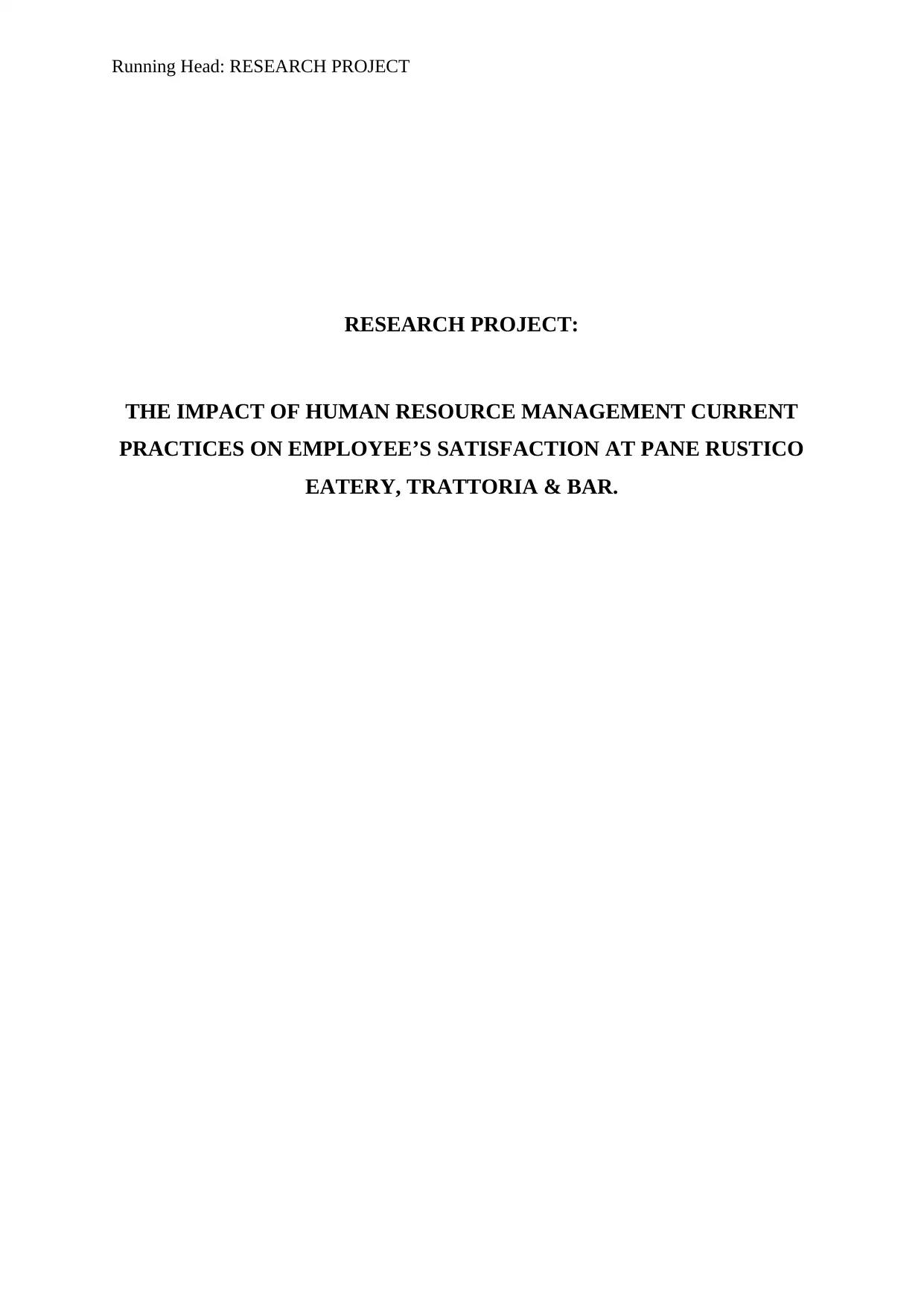
Running Head: RESEARCH PROJECT
RESEARCH PROJECT:
THE IMPACT OF HUMAN RESOURCE MANAGEMENT CURRENT
PRACTICES ON EMPLOYEE’S SATISFACTION AT PANE RUSTICO
EATERY, TRATTORIA & BAR.
RESEARCH PROJECT:
THE IMPACT OF HUMAN RESOURCE MANAGEMENT CURRENT
PRACTICES ON EMPLOYEE’S SATISFACTION AT PANE RUSTICO
EATERY, TRATTORIA & BAR.
Paraphrase This Document
Need a fresh take? Get an instant paraphrase of this document with our AI Paraphraser
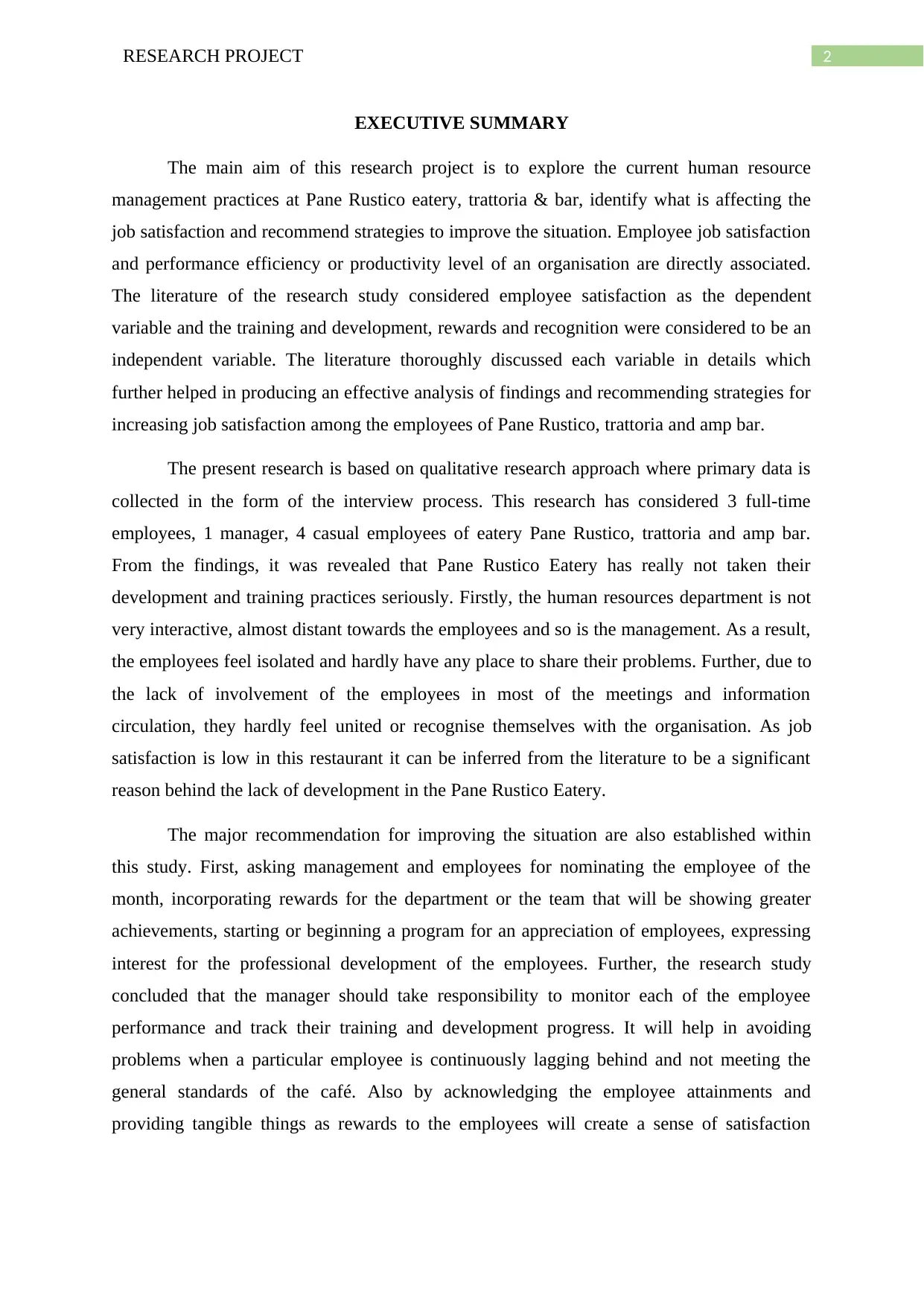
2RESEARCH PROJECT
EXECUTIVE SUMMARY
The main aim of this research project is to explore the current human resource
management practices at Pane Rustico eatery, trattoria & bar, identify what is affecting the
job satisfaction and recommend strategies to improve the situation. Employee job satisfaction
and performance efficiency or productivity level of an organisation are directly associated.
The literature of the research study considered employee satisfaction as the dependent
variable and the training and development, rewards and recognition were considered to be an
independent variable. The literature thoroughly discussed each variable in details which
further helped in producing an effective analysis of findings and recommending strategies for
increasing job satisfaction among the employees of Pane Rustico, trattoria and amp bar.
The present research is based on qualitative research approach where primary data is
collected in the form of the interview process. This research has considered 3 full-time
employees, 1 manager, 4 casual employees of eatery Pane Rustico, trattoria and amp bar.
From the findings, it was revealed that Pane Rustico Eatery has really not taken their
development and training practices seriously. Firstly, the human resources department is not
very interactive, almost distant towards the employees and so is the management. As a result,
the employees feel isolated and hardly have any place to share their problems. Further, due to
the lack of involvement of the employees in most of the meetings and information
circulation, they hardly feel united or recognise themselves with the organisation. As job
satisfaction is low in this restaurant it can be inferred from the literature to be a significant
reason behind the lack of development in the Pane Rustico Eatery.
The major recommendation for improving the situation are also established within
this study. First, asking management and employees for nominating the employee of the
month, incorporating rewards for the department or the team that will be showing greater
achievements, starting or beginning a program for an appreciation of employees, expressing
interest for the professional development of the employees. Further, the research study
concluded that the manager should take responsibility to monitor each of the employee
performance and track their training and development progress. It will help in avoiding
problems when a particular employee is continuously lagging behind and not meeting the
general standards of the café. Also by acknowledging the employee attainments and
providing tangible things as rewards to the employees will create a sense of satisfaction
EXECUTIVE SUMMARY
The main aim of this research project is to explore the current human resource
management practices at Pane Rustico eatery, trattoria & bar, identify what is affecting the
job satisfaction and recommend strategies to improve the situation. Employee job satisfaction
and performance efficiency or productivity level of an organisation are directly associated.
The literature of the research study considered employee satisfaction as the dependent
variable and the training and development, rewards and recognition were considered to be an
independent variable. The literature thoroughly discussed each variable in details which
further helped in producing an effective analysis of findings and recommending strategies for
increasing job satisfaction among the employees of Pane Rustico, trattoria and amp bar.
The present research is based on qualitative research approach where primary data is
collected in the form of the interview process. This research has considered 3 full-time
employees, 1 manager, 4 casual employees of eatery Pane Rustico, trattoria and amp bar.
From the findings, it was revealed that Pane Rustico Eatery has really not taken their
development and training practices seriously. Firstly, the human resources department is not
very interactive, almost distant towards the employees and so is the management. As a result,
the employees feel isolated and hardly have any place to share their problems. Further, due to
the lack of involvement of the employees in most of the meetings and information
circulation, they hardly feel united or recognise themselves with the organisation. As job
satisfaction is low in this restaurant it can be inferred from the literature to be a significant
reason behind the lack of development in the Pane Rustico Eatery.
The major recommendation for improving the situation are also established within
this study. First, asking management and employees for nominating the employee of the
month, incorporating rewards for the department or the team that will be showing greater
achievements, starting or beginning a program for an appreciation of employees, expressing
interest for the professional development of the employees. Further, the research study
concluded that the manager should take responsibility to monitor each of the employee
performance and track their training and development progress. It will help in avoiding
problems when a particular employee is continuously lagging behind and not meeting the
general standards of the café. Also by acknowledging the employee attainments and
providing tangible things as rewards to the employees will create a sense of satisfaction
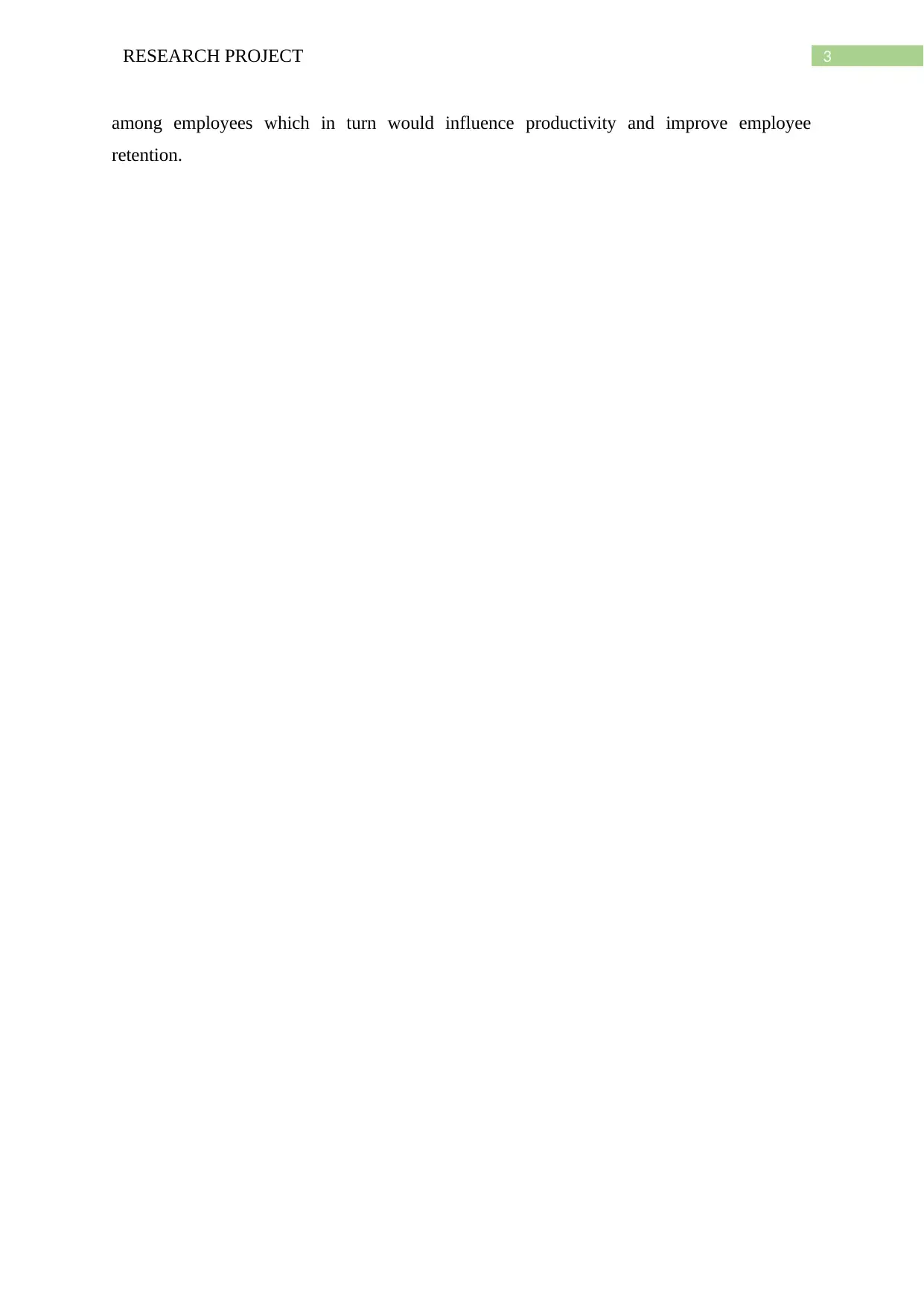
3RESEARCH PROJECT
among employees which in turn would influence productivity and improve employee
retention.
among employees which in turn would influence productivity and improve employee
retention.
⊘ This is a preview!⊘
Do you want full access?
Subscribe today to unlock all pages.

Trusted by 1+ million students worldwide
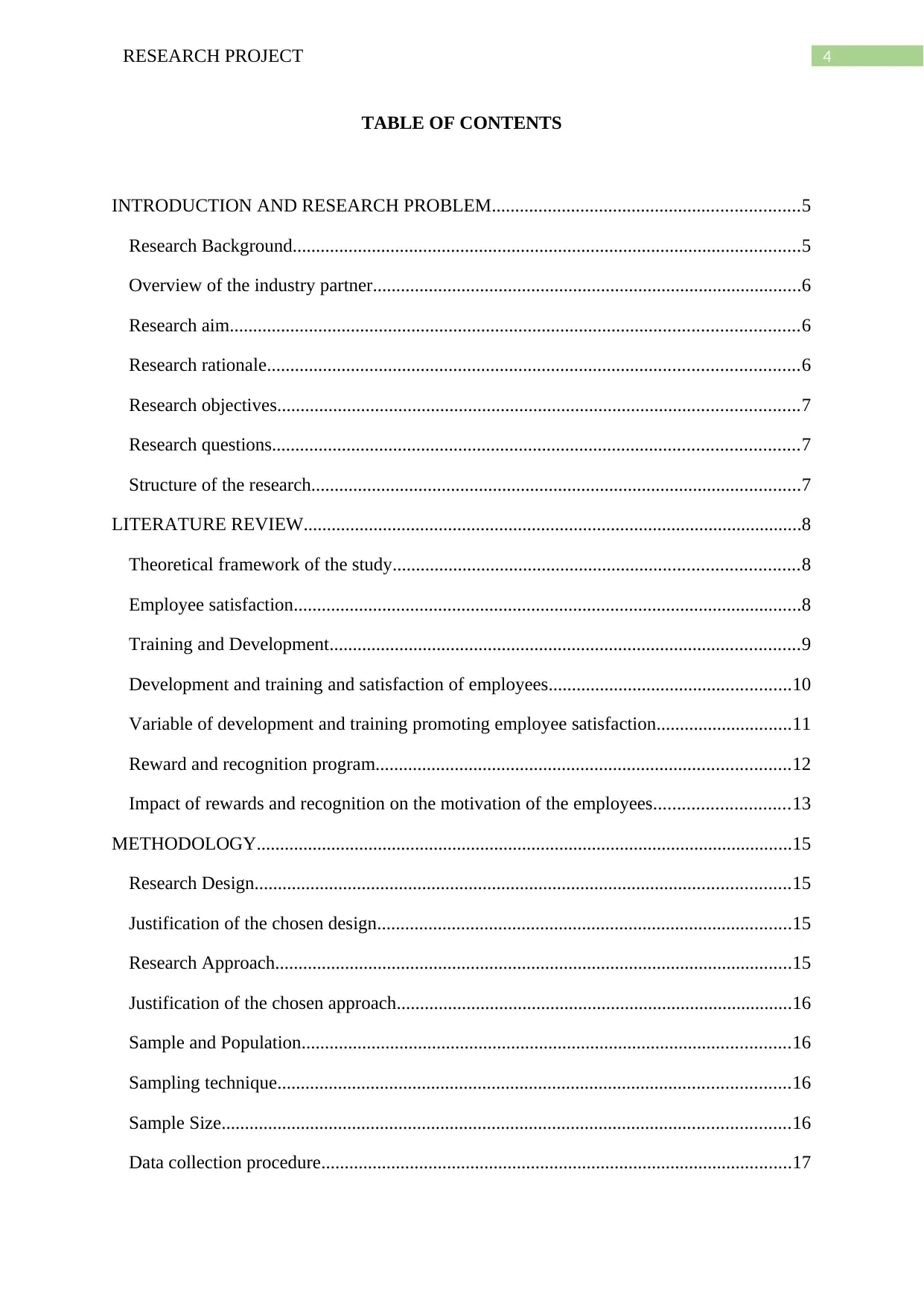
4RESEARCH PROJECT
TABLE OF CONTENTS
INTRODUCTION AND RESEARCH PROBLEM..................................................................5
Research Background.............................................................................................................5
Overview of the industry partner............................................................................................6
Research aim..........................................................................................................................6
Research rationale..................................................................................................................6
Research objectives................................................................................................................7
Research questions.................................................................................................................7
Structure of the research.........................................................................................................7
LITERATURE REVIEW...........................................................................................................8
Theoretical framework of the study.......................................................................................8
Employee satisfaction.............................................................................................................8
Training and Development.....................................................................................................9
Development and training and satisfaction of employees....................................................10
Variable of development and training promoting employee satisfaction.............................11
Reward and recognition program.........................................................................................12
Impact of rewards and recognition on the motivation of the employees.............................13
METHODOLOGY...................................................................................................................15
Research Design...................................................................................................................15
Justification of the chosen design.........................................................................................15
Research Approach...............................................................................................................15
Justification of the chosen approach.....................................................................................16
Sample and Population.........................................................................................................16
Sampling technique..............................................................................................................16
Sample Size..........................................................................................................................16
Data collection procedure.....................................................................................................17
TABLE OF CONTENTS
INTRODUCTION AND RESEARCH PROBLEM..................................................................5
Research Background.............................................................................................................5
Overview of the industry partner............................................................................................6
Research aim..........................................................................................................................6
Research rationale..................................................................................................................6
Research objectives................................................................................................................7
Research questions.................................................................................................................7
Structure of the research.........................................................................................................7
LITERATURE REVIEW...........................................................................................................8
Theoretical framework of the study.......................................................................................8
Employee satisfaction.............................................................................................................8
Training and Development.....................................................................................................9
Development and training and satisfaction of employees....................................................10
Variable of development and training promoting employee satisfaction.............................11
Reward and recognition program.........................................................................................12
Impact of rewards and recognition on the motivation of the employees.............................13
METHODOLOGY...................................................................................................................15
Research Design...................................................................................................................15
Justification of the chosen design.........................................................................................15
Research Approach...............................................................................................................15
Justification of the chosen approach.....................................................................................16
Sample and Population.........................................................................................................16
Sampling technique..............................................................................................................16
Sample Size..........................................................................................................................16
Data collection procedure.....................................................................................................17
Paraphrase This Document
Need a fresh take? Get an instant paraphrase of this document with our AI Paraphraser
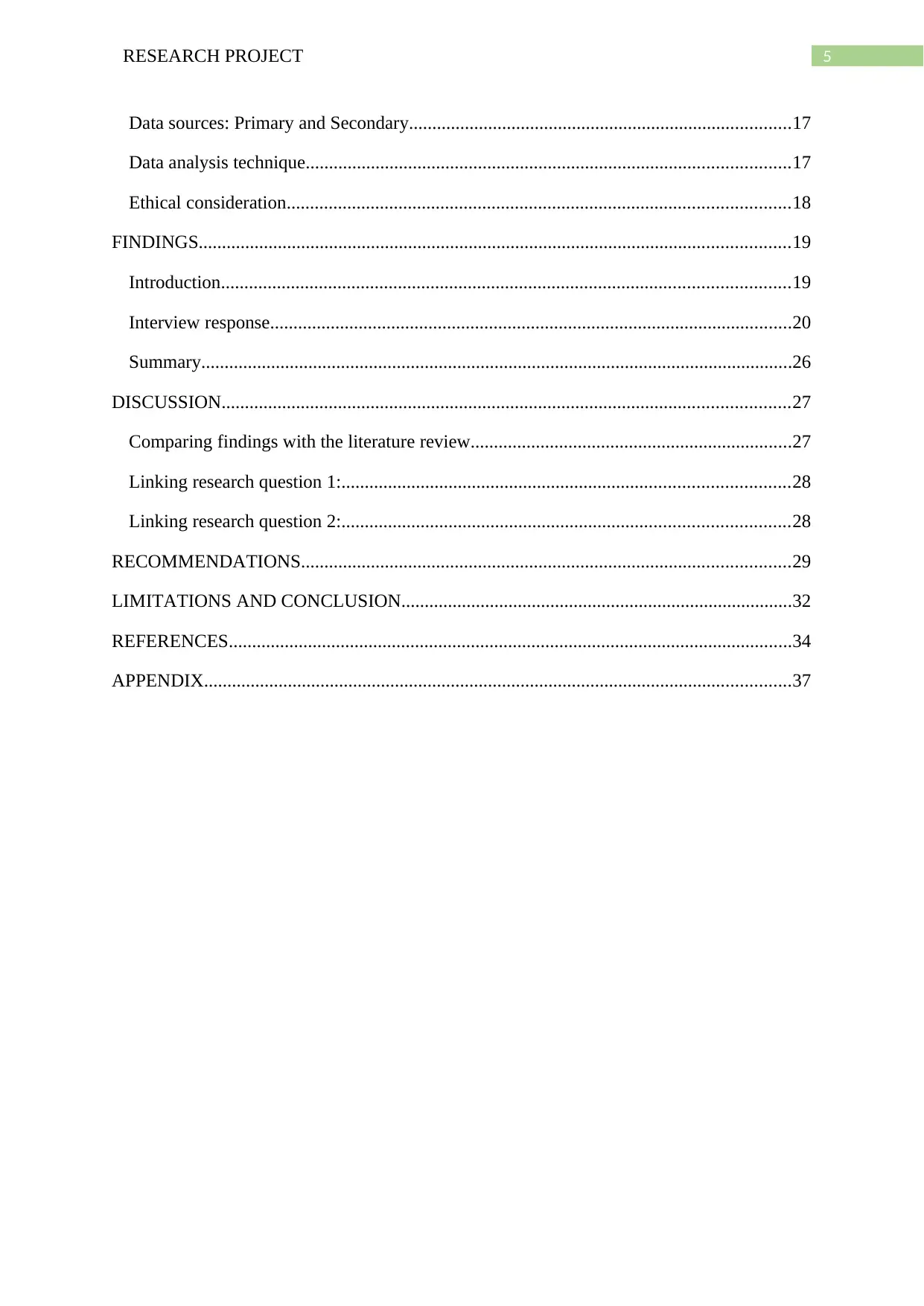
5RESEARCH PROJECT
Data sources: Primary and Secondary..................................................................................17
Data analysis technique........................................................................................................17
Ethical consideration............................................................................................................18
FINDINGS...............................................................................................................................19
Introduction..........................................................................................................................19
Interview response................................................................................................................20
Summary...............................................................................................................................26
DISCUSSION..........................................................................................................................27
Comparing findings with the literature review.....................................................................27
Linking research question 1:................................................................................................28
Linking research question 2:................................................................................................28
RECOMMENDATIONS.........................................................................................................29
LIMITATIONS AND CONCLUSION....................................................................................32
REFERENCES.........................................................................................................................34
APPENDIX..............................................................................................................................37
Data sources: Primary and Secondary..................................................................................17
Data analysis technique........................................................................................................17
Ethical consideration............................................................................................................18
FINDINGS...............................................................................................................................19
Introduction..........................................................................................................................19
Interview response................................................................................................................20
Summary...............................................................................................................................26
DISCUSSION..........................................................................................................................27
Comparing findings with the literature review.....................................................................27
Linking research question 1:................................................................................................28
Linking research question 2:................................................................................................28
RECOMMENDATIONS.........................................................................................................29
LIMITATIONS AND CONCLUSION....................................................................................32
REFERENCES.........................................................................................................................34
APPENDIX..............................................................................................................................37
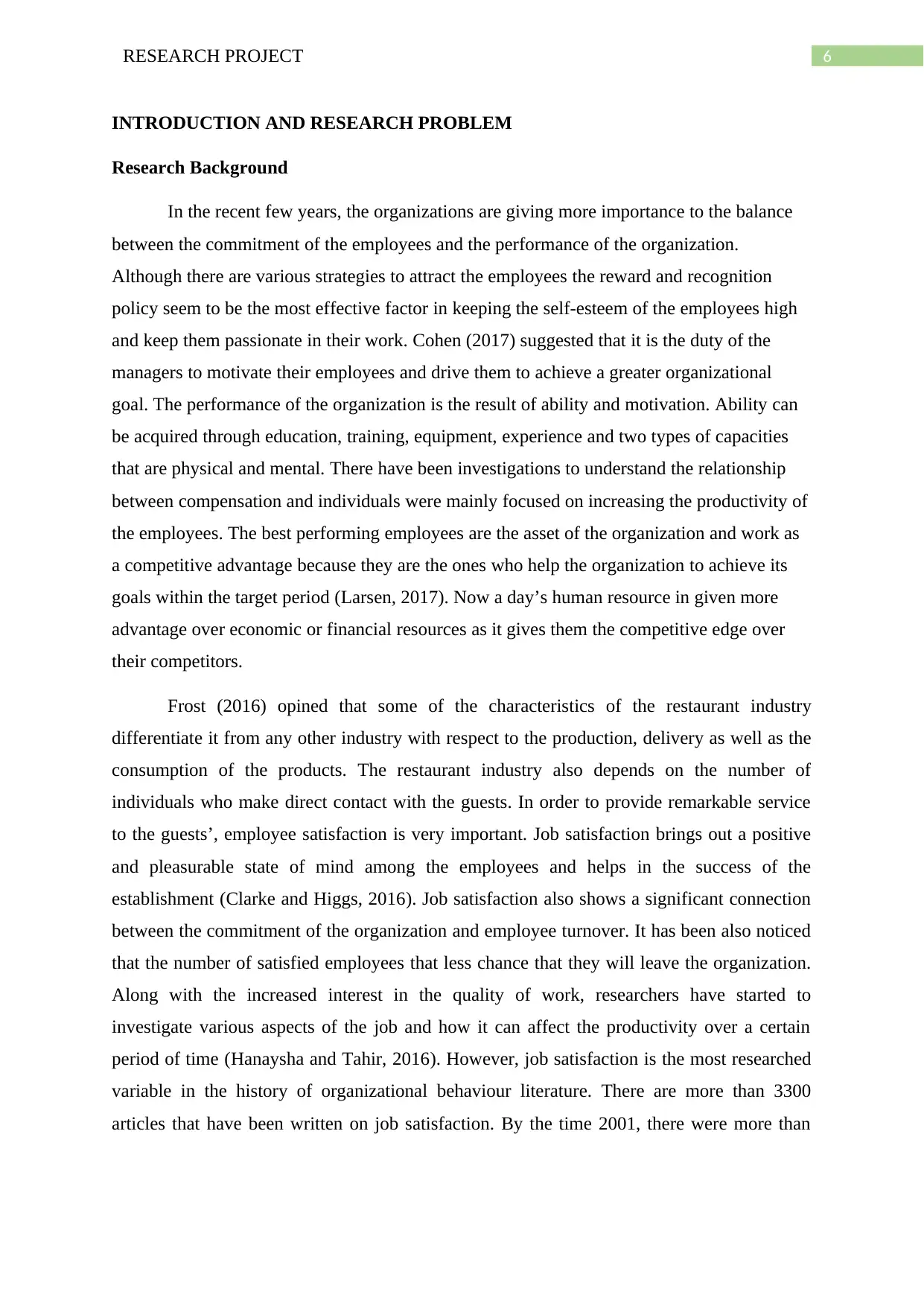
6RESEARCH PROJECT
INTRODUCTION AND RESEARCH PROBLEM
Research Background
In the recent few years, the organizations are giving more importance to the balance
between the commitment of the employees and the performance of the organization.
Although there are various strategies to attract the employees the reward and recognition
policy seem to be the most effective factor in keeping the self-esteem of the employees high
and keep them passionate in their work. Cohen (2017) suggested that it is the duty of the
managers to motivate their employees and drive them to achieve a greater organizational
goal. The performance of the organization is the result of ability and motivation. Ability can
be acquired through education, training, equipment, experience and two types of capacities
that are physical and mental. There have been investigations to understand the relationship
between compensation and individuals were mainly focused on increasing the productivity of
the employees. The best performing employees are the asset of the organization and work as
a competitive advantage because they are the ones who help the organization to achieve its
goals within the target period (Larsen, 2017). Now a day’s human resource in given more
advantage over economic or financial resources as it gives them the competitive edge over
their competitors.
Frost (2016) opined that some of the characteristics of the restaurant industry
differentiate it from any other industry with respect to the production, delivery as well as the
consumption of the products. The restaurant industry also depends on the number of
individuals who make direct contact with the guests. In order to provide remarkable service
to the guests’, employee satisfaction is very important. Job satisfaction brings out a positive
and pleasurable state of mind among the employees and helps in the success of the
establishment (Clarke and Higgs, 2016). Job satisfaction also shows a significant connection
between the commitment of the organization and employee turnover. It has been also noticed
that the number of satisfied employees that less chance that they will leave the organization.
Along with the increased interest in the quality of work, researchers have started to
investigate various aspects of the job and how it can affect the productivity over a certain
period of time (Hanaysha and Tahir, 2016). However, job satisfaction is the most researched
variable in the history of organizational behaviour literature. There are more than 3300
articles that have been written on job satisfaction. By the time 2001, there were more than
INTRODUCTION AND RESEARCH PROBLEM
Research Background
In the recent few years, the organizations are giving more importance to the balance
between the commitment of the employees and the performance of the organization.
Although there are various strategies to attract the employees the reward and recognition
policy seem to be the most effective factor in keeping the self-esteem of the employees high
and keep them passionate in their work. Cohen (2017) suggested that it is the duty of the
managers to motivate their employees and drive them to achieve a greater organizational
goal. The performance of the organization is the result of ability and motivation. Ability can
be acquired through education, training, equipment, experience and two types of capacities
that are physical and mental. There have been investigations to understand the relationship
between compensation and individuals were mainly focused on increasing the productivity of
the employees. The best performing employees are the asset of the organization and work as
a competitive advantage because they are the ones who help the organization to achieve its
goals within the target period (Larsen, 2017). Now a day’s human resource in given more
advantage over economic or financial resources as it gives them the competitive edge over
their competitors.
Frost (2016) opined that some of the characteristics of the restaurant industry
differentiate it from any other industry with respect to the production, delivery as well as the
consumption of the products. The restaurant industry also depends on the number of
individuals who make direct contact with the guests. In order to provide remarkable service
to the guests’, employee satisfaction is very important. Job satisfaction brings out a positive
and pleasurable state of mind among the employees and helps in the success of the
establishment (Clarke and Higgs, 2016). Job satisfaction also shows a significant connection
between the commitment of the organization and employee turnover. It has been also noticed
that the number of satisfied employees that less chance that they will leave the organization.
Along with the increased interest in the quality of work, researchers have started to
investigate various aspects of the job and how it can affect the productivity over a certain
period of time (Hanaysha and Tahir, 2016). However, job satisfaction is the most researched
variable in the history of organizational behaviour literature. There are more than 3300
articles that have been written on job satisfaction. By the time 2001, there were more than
⊘ This is a preview!⊘
Do you want full access?
Subscribe today to unlock all pages.

Trusted by 1+ million students worldwide
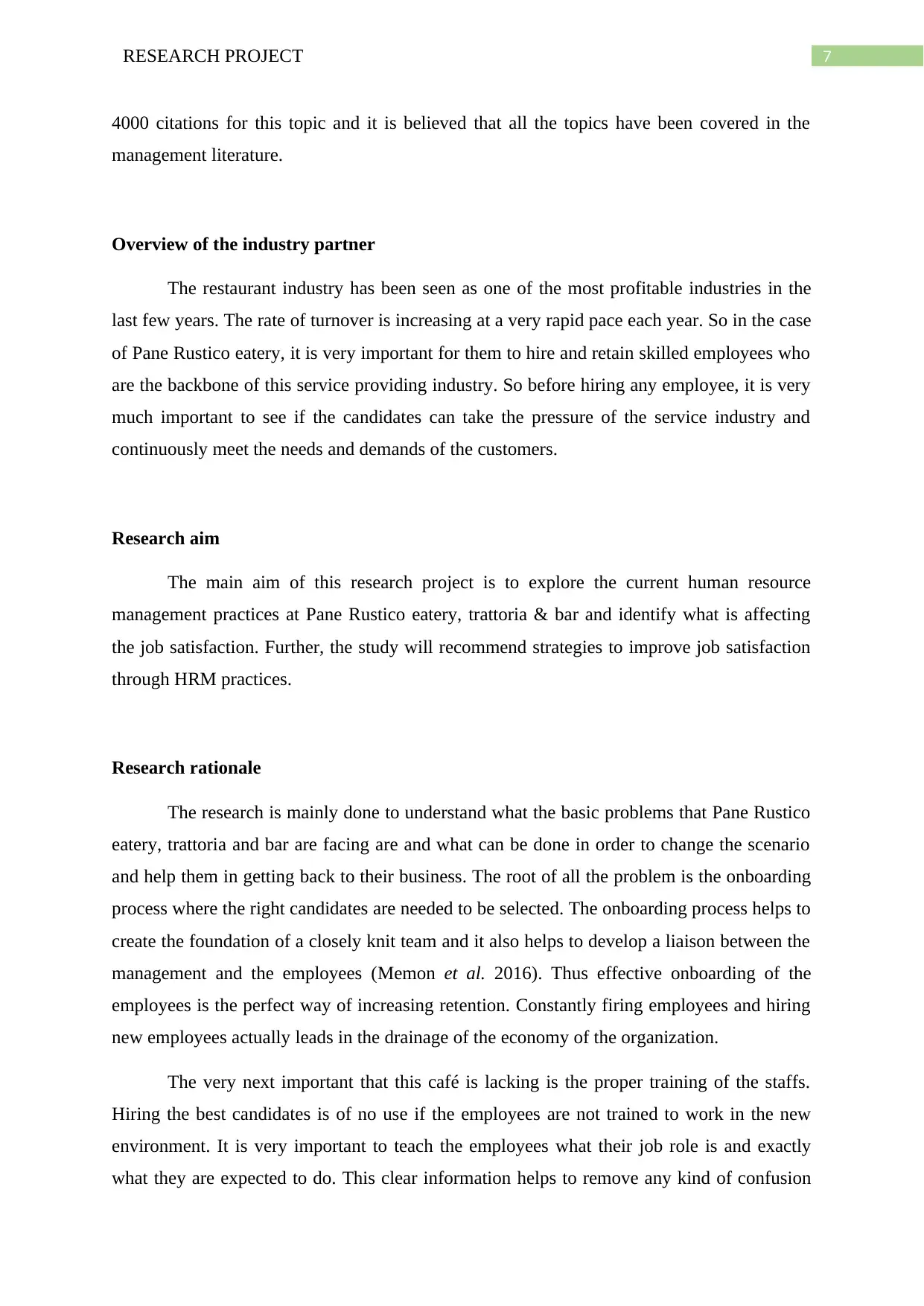
7RESEARCH PROJECT
4000 citations for this topic and it is believed that all the topics have been covered in the
management literature.
Overview of the industry partner
The restaurant industry has been seen as one of the most profitable industries in the
last few years. The rate of turnover is increasing at a very rapid pace each year. So in the case
of Pane Rustico eatery, it is very important for them to hire and retain skilled employees who
are the backbone of this service providing industry. So before hiring any employee, it is very
much important to see if the candidates can take the pressure of the service industry and
continuously meet the needs and demands of the customers.
Research aim
The main aim of this research project is to explore the current human resource
management practices at Pane Rustico eatery, trattoria & bar and identify what is affecting
the job satisfaction. Further, the study will recommend strategies to improve job satisfaction
through HRM practices.
Research rationale
The research is mainly done to understand what the basic problems that Pane Rustico
eatery, trattoria and bar are facing are and what can be done in order to change the scenario
and help them in getting back to their business. The root of all the problem is the onboarding
process where the right candidates are needed to be selected. The onboarding process helps to
create the foundation of a closely knit team and it also helps to develop a liaison between the
management and the employees (Memon et al. 2016). Thus effective onboarding of the
employees is the perfect way of increasing retention. Constantly firing employees and hiring
new employees actually leads in the drainage of the economy of the organization.
The very next important that this café is lacking is the proper training of the staffs.
Hiring the best candidates is of no use if the employees are not trained to work in the new
environment. It is very important to teach the employees what their job role is and exactly
what they are expected to do. This clear information helps to remove any kind of confusion
4000 citations for this topic and it is believed that all the topics have been covered in the
management literature.
Overview of the industry partner
The restaurant industry has been seen as one of the most profitable industries in the
last few years. The rate of turnover is increasing at a very rapid pace each year. So in the case
of Pane Rustico eatery, it is very important for them to hire and retain skilled employees who
are the backbone of this service providing industry. So before hiring any employee, it is very
much important to see if the candidates can take the pressure of the service industry and
continuously meet the needs and demands of the customers.
Research aim
The main aim of this research project is to explore the current human resource
management practices at Pane Rustico eatery, trattoria & bar and identify what is affecting
the job satisfaction. Further, the study will recommend strategies to improve job satisfaction
through HRM practices.
Research rationale
The research is mainly done to understand what the basic problems that Pane Rustico
eatery, trattoria and bar are facing are and what can be done in order to change the scenario
and help them in getting back to their business. The root of all the problem is the onboarding
process where the right candidates are needed to be selected. The onboarding process helps to
create the foundation of a closely knit team and it also helps to develop a liaison between the
management and the employees (Memon et al. 2016). Thus effective onboarding of the
employees is the perfect way of increasing retention. Constantly firing employees and hiring
new employees actually leads in the drainage of the economy of the organization.
The very next important that this café is lacking is the proper training of the staffs.
Hiring the best candidates is of no use if the employees are not trained to work in the new
environment. It is very important to teach the employees what their job role is and exactly
what they are expected to do. This clear information helps to remove any kind of confusion
Paraphrase This Document
Need a fresh take? Get an instant paraphrase of this document with our AI Paraphraser
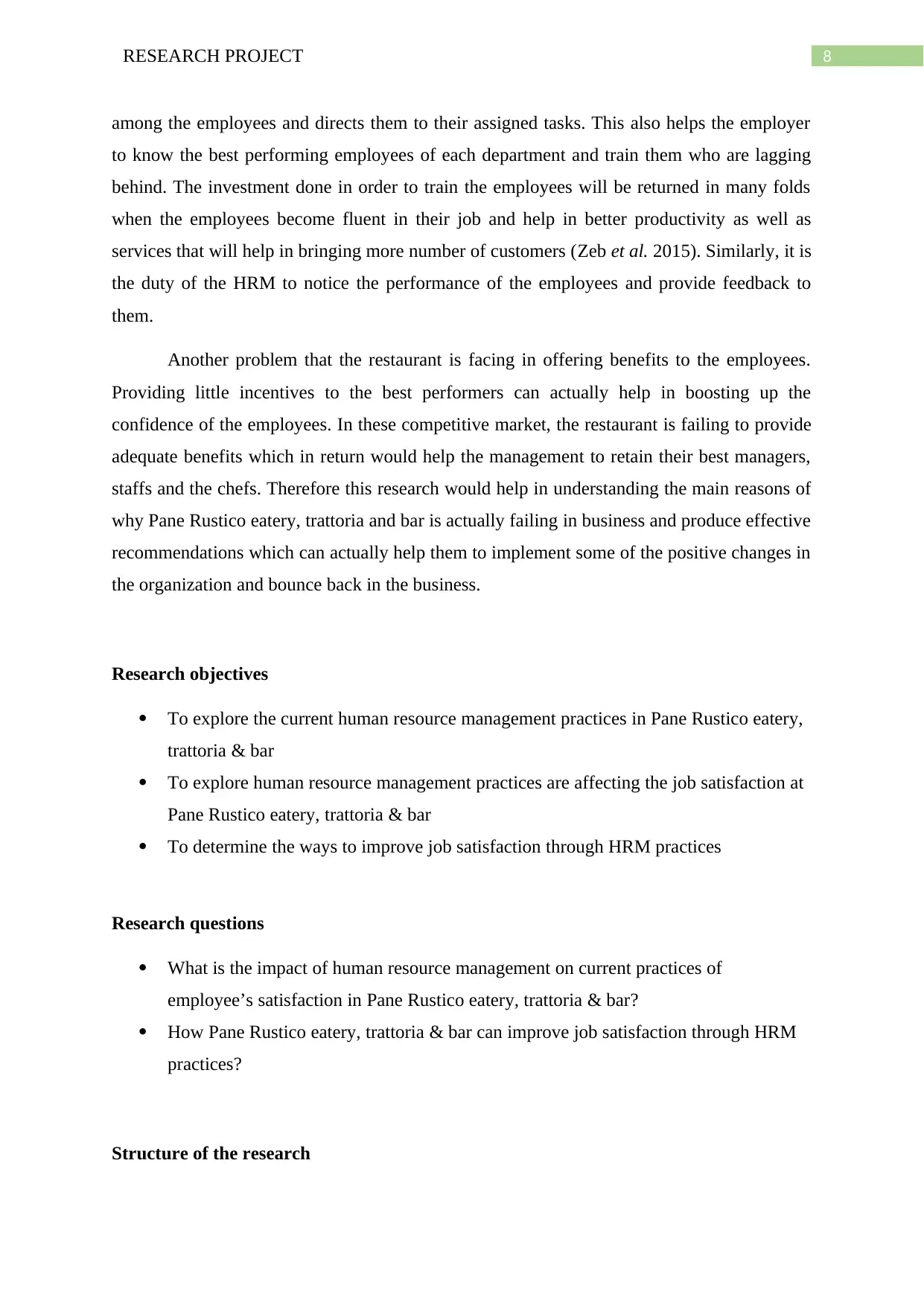
8RESEARCH PROJECT
among the employees and directs them to their assigned tasks. This also helps the employer
to know the best performing employees of each department and train them who are lagging
behind. The investment done in order to train the employees will be returned in many folds
when the employees become fluent in their job and help in better productivity as well as
services that will help in bringing more number of customers (Zeb et al. 2015). Similarly, it is
the duty of the HRM to notice the performance of the employees and provide feedback to
them.
Another problem that the restaurant is facing in offering benefits to the employees.
Providing little incentives to the best performers can actually help in boosting up the
confidence of the employees. In these competitive market, the restaurant is failing to provide
adequate benefits which in return would help the management to retain their best managers,
staffs and the chefs. Therefore this research would help in understanding the main reasons of
why Pane Rustico eatery, trattoria and bar is actually failing in business and produce effective
recommendations which can actually help them to implement some of the positive changes in
the organization and bounce back in the business.
Research objectives
To explore the current human resource management practices in Pane Rustico eatery,
trattoria & bar
To explore human resource management practices are affecting the job satisfaction at
Pane Rustico eatery, trattoria & bar
To determine the ways to improve job satisfaction through HRM practices
Research questions
What is the impact of human resource management on current practices of
employee’s satisfaction in Pane Rustico eatery, trattoria & bar?
How Pane Rustico eatery, trattoria & bar can improve job satisfaction through HRM
practices?
Structure of the research
among the employees and directs them to their assigned tasks. This also helps the employer
to know the best performing employees of each department and train them who are lagging
behind. The investment done in order to train the employees will be returned in many folds
when the employees become fluent in their job and help in better productivity as well as
services that will help in bringing more number of customers (Zeb et al. 2015). Similarly, it is
the duty of the HRM to notice the performance of the employees and provide feedback to
them.
Another problem that the restaurant is facing in offering benefits to the employees.
Providing little incentives to the best performers can actually help in boosting up the
confidence of the employees. In these competitive market, the restaurant is failing to provide
adequate benefits which in return would help the management to retain their best managers,
staffs and the chefs. Therefore this research would help in understanding the main reasons of
why Pane Rustico eatery, trattoria and bar is actually failing in business and produce effective
recommendations which can actually help them to implement some of the positive changes in
the organization and bounce back in the business.
Research objectives
To explore the current human resource management practices in Pane Rustico eatery,
trattoria & bar
To explore human resource management practices are affecting the job satisfaction at
Pane Rustico eatery, trattoria & bar
To determine the ways to improve job satisfaction through HRM practices
Research questions
What is the impact of human resource management on current practices of
employee’s satisfaction in Pane Rustico eatery, trattoria & bar?
How Pane Rustico eatery, trattoria & bar can improve job satisfaction through HRM
practices?
Structure of the research
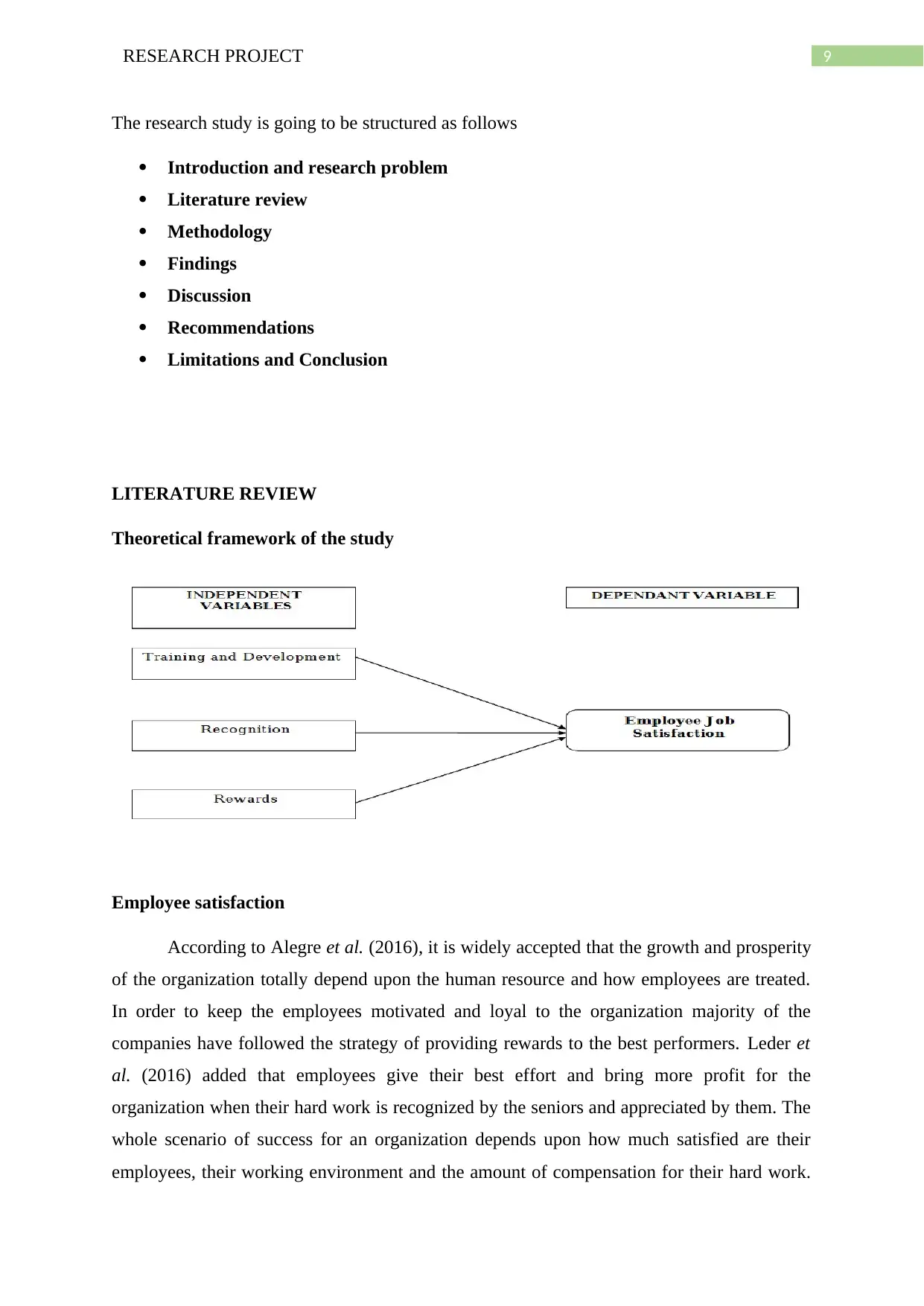
9RESEARCH PROJECT
The research study is going to be structured as follows
Introduction and research problem
Literature review
Methodology
Findings
Discussion
Recommendations
Limitations and Conclusion
LITERATURE REVIEW
Theoretical framework of the study
Employee satisfaction
According to Alegre et al. (2016), it is widely accepted that the growth and prosperity
of the organization totally depend upon the human resource and how employees are treated.
In order to keep the employees motivated and loyal to the organization majority of the
companies have followed the strategy of providing rewards to the best performers. Leder et
al. (2016) added that employees give their best effort and bring more profit for the
organization when their hard work is recognized by the seniors and appreciated by them. The
whole scenario of success for an organization depends upon how much satisfied are their
employees, their working environment and the amount of compensation for their hard work.
The research study is going to be structured as follows
Introduction and research problem
Literature review
Methodology
Findings
Discussion
Recommendations
Limitations and Conclusion
LITERATURE REVIEW
Theoretical framework of the study
Employee satisfaction
According to Alegre et al. (2016), it is widely accepted that the growth and prosperity
of the organization totally depend upon the human resource and how employees are treated.
In order to keep the employees motivated and loyal to the organization majority of the
companies have followed the strategy of providing rewards to the best performers. Leder et
al. (2016) added that employees give their best effort and bring more profit for the
organization when their hard work is recognized by the seniors and appreciated by them. The
whole scenario of success for an organization depends upon how much satisfied are their
employees, their working environment and the amount of compensation for their hard work.
⊘ This is a preview!⊘
Do you want full access?
Subscribe today to unlock all pages.

Trusted by 1+ million students worldwide
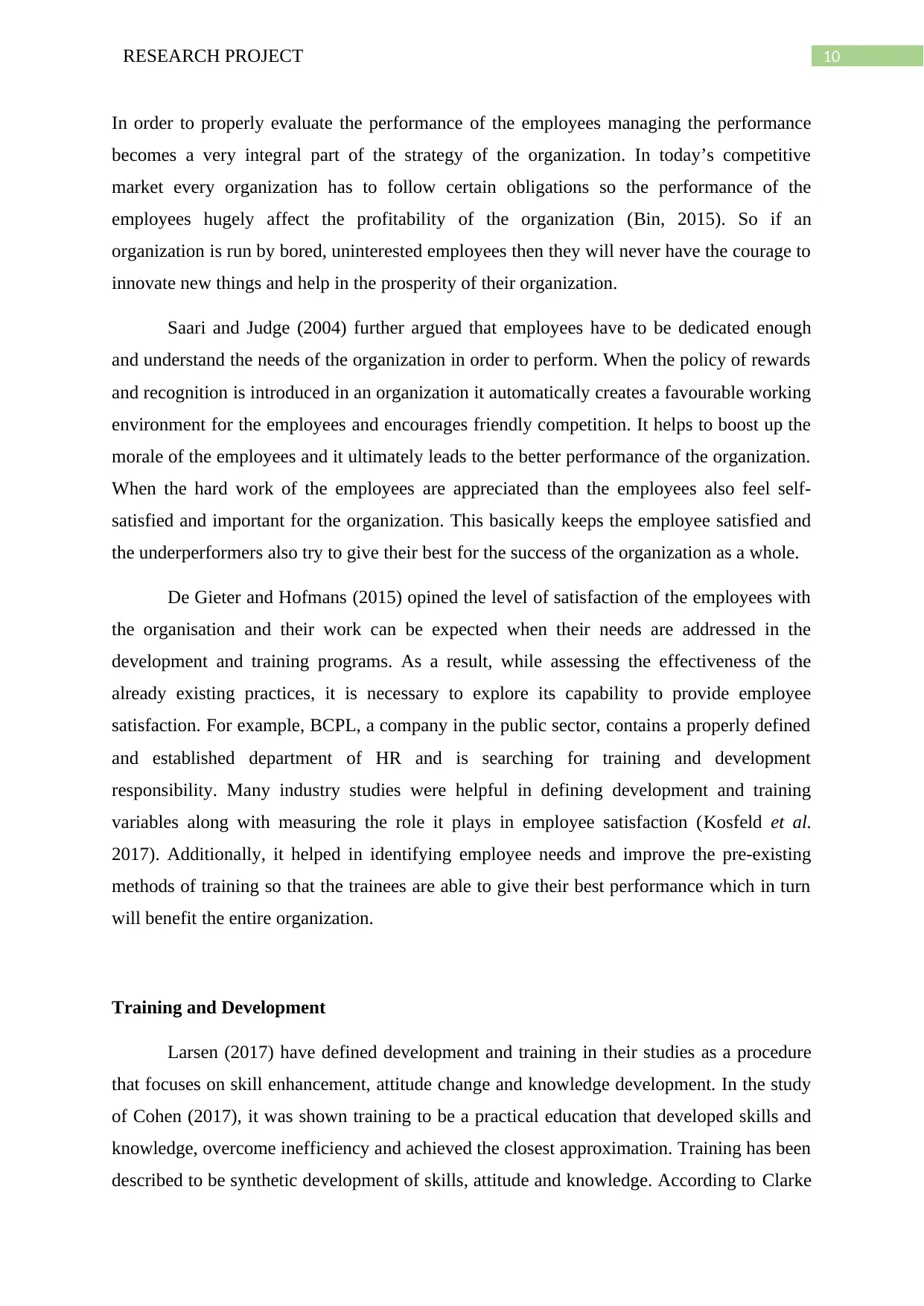
10RESEARCH PROJECT
In order to properly evaluate the performance of the employees managing the performance
becomes a very integral part of the strategy of the organization. In today’s competitive
market every organization has to follow certain obligations so the performance of the
employees hugely affect the profitability of the organization (Bin, 2015). So if an
organization is run by bored, uninterested employees then they will never have the courage to
innovate new things and help in the prosperity of their organization.
Saari and Judge (2004) further argued that employees have to be dedicated enough
and understand the needs of the organization in order to perform. When the policy of rewards
and recognition is introduced in an organization it automatically creates a favourable working
environment for the employees and encourages friendly competition. It helps to boost up the
morale of the employees and it ultimately leads to the better performance of the organization.
When the hard work of the employees are appreciated than the employees also feel self-
satisfied and important for the organization. This basically keeps the employee satisfied and
the underperformers also try to give their best for the success of the organization as a whole.
De Gieter and Hofmans (2015) opined the level of satisfaction of the employees with
the organisation and their work can be expected when their needs are addressed in the
development and training programs. As a result, while assessing the effectiveness of the
already existing practices, it is necessary to explore its capability to provide employee
satisfaction. For example, BCPL, a company in the public sector, contains a properly defined
and established department of HR and is searching for training and development
responsibility. Many industry studies were helpful in defining development and training
variables along with measuring the role it plays in employee satisfaction (Kosfeld et al.
2017). Additionally, it helped in identifying employee needs and improve the pre-existing
methods of training so that the trainees are able to give their best performance which in turn
will benefit the entire organization.
Training and Development
Larsen (2017) have defined development and training in their studies as a procedure
that focuses on skill enhancement, attitude change and knowledge development. In the study
of Cohen (2017), it was shown training to be a practical education that developed skills and
knowledge, overcome inefficiency and achieved the closest approximation. Training has been
described to be synthetic development of skills, attitude and knowledge. According to Clarke
In order to properly evaluate the performance of the employees managing the performance
becomes a very integral part of the strategy of the organization. In today’s competitive
market every organization has to follow certain obligations so the performance of the
employees hugely affect the profitability of the organization (Bin, 2015). So if an
organization is run by bored, uninterested employees then they will never have the courage to
innovate new things and help in the prosperity of their organization.
Saari and Judge (2004) further argued that employees have to be dedicated enough
and understand the needs of the organization in order to perform. When the policy of rewards
and recognition is introduced in an organization it automatically creates a favourable working
environment for the employees and encourages friendly competition. It helps to boost up the
morale of the employees and it ultimately leads to the better performance of the organization.
When the hard work of the employees are appreciated than the employees also feel self-
satisfied and important for the organization. This basically keeps the employee satisfied and
the underperformers also try to give their best for the success of the organization as a whole.
De Gieter and Hofmans (2015) opined the level of satisfaction of the employees with
the organisation and their work can be expected when their needs are addressed in the
development and training programs. As a result, while assessing the effectiveness of the
already existing practices, it is necessary to explore its capability to provide employee
satisfaction. For example, BCPL, a company in the public sector, contains a properly defined
and established department of HR and is searching for training and development
responsibility. Many industry studies were helpful in defining development and training
variables along with measuring the role it plays in employee satisfaction (Kosfeld et al.
2017). Additionally, it helped in identifying employee needs and improve the pre-existing
methods of training so that the trainees are able to give their best performance which in turn
will benefit the entire organization.
Training and Development
Larsen (2017) have defined development and training in their studies as a procedure
that focuses on skill enhancement, attitude change and knowledge development. In the study
of Cohen (2017), it was shown training to be a practical education that developed skills and
knowledge, overcome inefficiency and achieved the closest approximation. Training has been
described to be synthetic development of skills, attitude and knowledge. According to Clarke
Paraphrase This Document
Need a fresh take? Get an instant paraphrase of this document with our AI Paraphraser
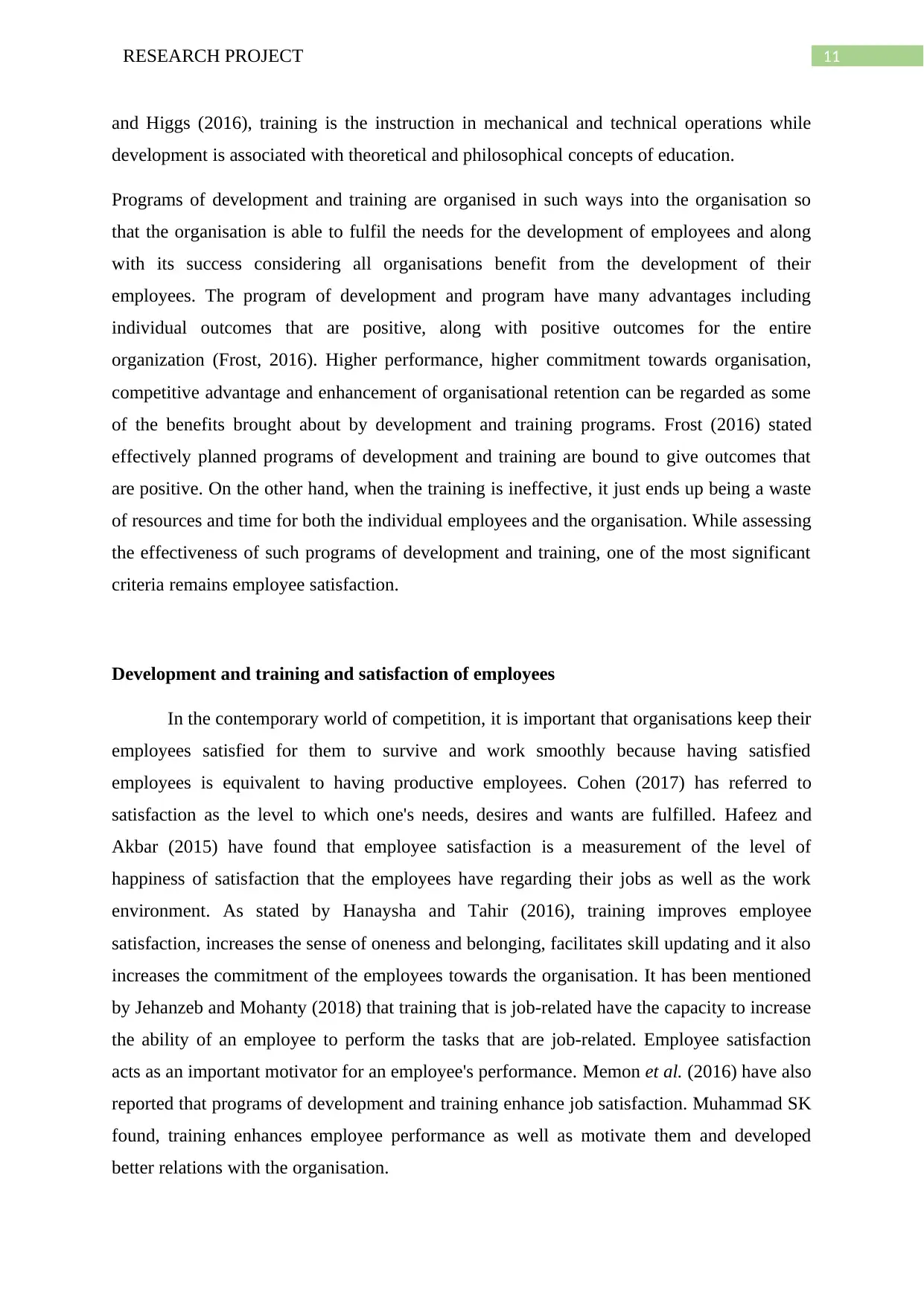
11RESEARCH PROJECT
and Higgs (2016), training is the instruction in mechanical and technical operations while
development is associated with theoretical and philosophical concepts of education.
Programs of development and training are organised in such ways into the organisation so
that the organisation is able to fulfil the needs for the development of employees and along
with its success considering all organisations benefit from the development of their
employees. The program of development and program have many advantages including
individual outcomes that are positive, along with positive outcomes for the entire
organization (Frost, 2016). Higher performance, higher commitment towards organisation,
competitive advantage and enhancement of organisational retention can be regarded as some
of the benefits brought about by development and training programs. Frost (2016) stated
effectively planned programs of development and training are bound to give outcomes that
are positive. On the other hand, when the training is ineffective, it just ends up being a waste
of resources and time for both the individual employees and the organisation. While assessing
the effectiveness of such programs of development and training, one of the most significant
criteria remains employee satisfaction.
Development and training and satisfaction of employees
In the contemporary world of competition, it is important that organisations keep their
employees satisfied for them to survive and work smoothly because having satisfied
employees is equivalent to having productive employees. Cohen (2017) has referred to
satisfaction as the level to which one's needs, desires and wants are fulfilled. Hafeez and
Akbar (2015) have found that employee satisfaction is a measurement of the level of
happiness of satisfaction that the employees have regarding their jobs as well as the work
environment. As stated by Hanaysha and Tahir (2016), training improves employee
satisfaction, increases the sense of oneness and belonging, facilitates skill updating and it also
increases the commitment of the employees towards the organisation. It has been mentioned
by Jehanzeb and Mohanty (2018) that training that is job-related have the capacity to increase
the ability of an employee to perform the tasks that are job-related. Employee satisfaction
acts as an important motivator for an employee's performance. Memon et al. (2016) have also
reported that programs of development and training enhance job satisfaction. Muhammad SK
found, training enhances employee performance as well as motivate them and developed
better relations with the organisation.
and Higgs (2016), training is the instruction in mechanical and technical operations while
development is associated with theoretical and philosophical concepts of education.
Programs of development and training are organised in such ways into the organisation so
that the organisation is able to fulfil the needs for the development of employees and along
with its success considering all organisations benefit from the development of their
employees. The program of development and program have many advantages including
individual outcomes that are positive, along with positive outcomes for the entire
organization (Frost, 2016). Higher performance, higher commitment towards organisation,
competitive advantage and enhancement of organisational retention can be regarded as some
of the benefits brought about by development and training programs. Frost (2016) stated
effectively planned programs of development and training are bound to give outcomes that
are positive. On the other hand, when the training is ineffective, it just ends up being a waste
of resources and time for both the individual employees and the organisation. While assessing
the effectiveness of such programs of development and training, one of the most significant
criteria remains employee satisfaction.
Development and training and satisfaction of employees
In the contemporary world of competition, it is important that organisations keep their
employees satisfied for them to survive and work smoothly because having satisfied
employees is equivalent to having productive employees. Cohen (2017) has referred to
satisfaction as the level to which one's needs, desires and wants are fulfilled. Hafeez and
Akbar (2015) have found that employee satisfaction is a measurement of the level of
happiness of satisfaction that the employees have regarding their jobs as well as the work
environment. As stated by Hanaysha and Tahir (2016), training improves employee
satisfaction, increases the sense of oneness and belonging, facilitates skill updating and it also
increases the commitment of the employees towards the organisation. It has been mentioned
by Jehanzeb and Mohanty (2018) that training that is job-related have the capacity to increase
the ability of an employee to perform the tasks that are job-related. Employee satisfaction
acts as an important motivator for an employee's performance. Memon et al. (2016) have also
reported that programs of development and training enhance job satisfaction. Muhammad SK
found, training enhances employee performance as well as motivate them and developed
better relations with the organisation.
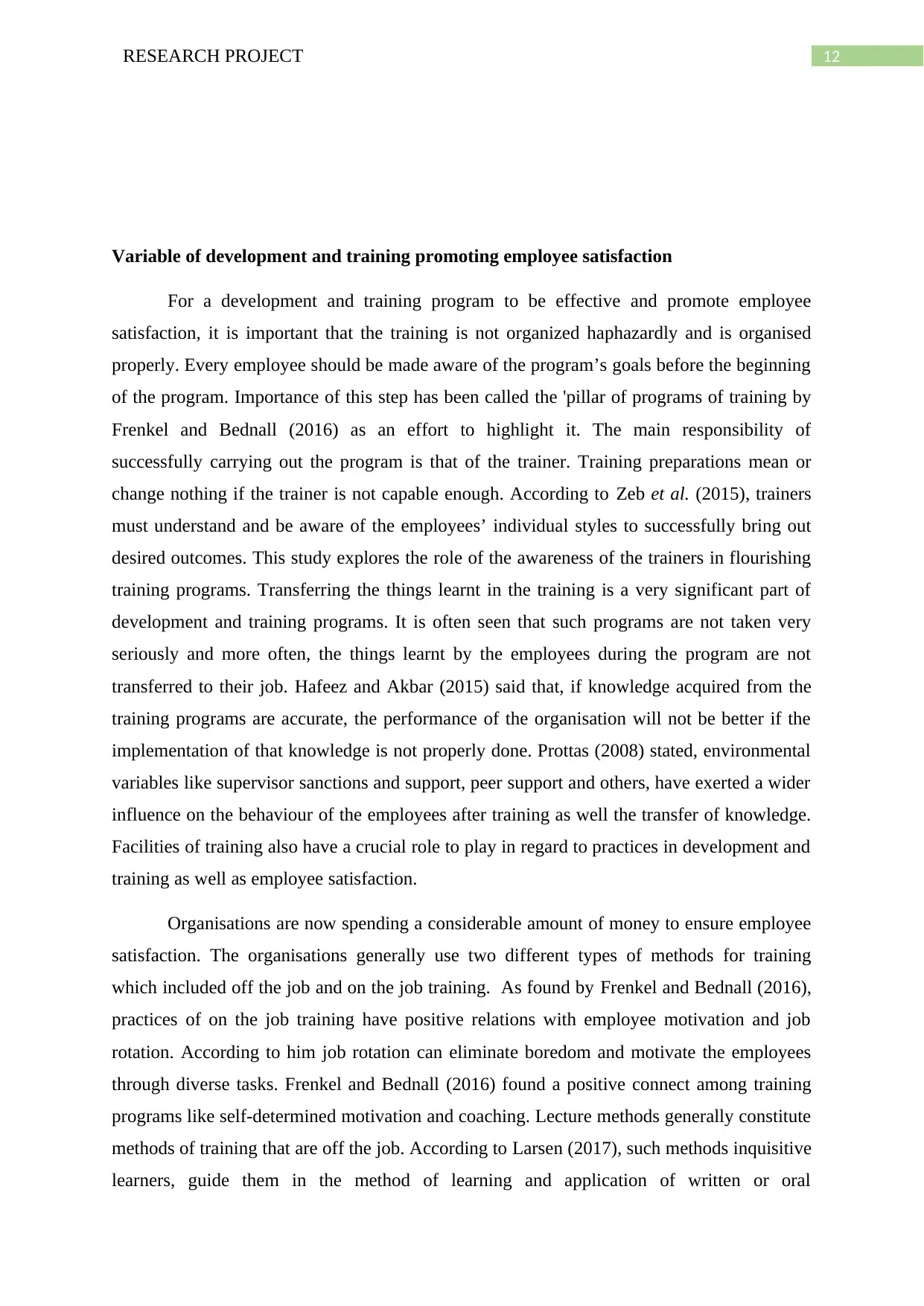
12RESEARCH PROJECT
Variable of development and training promoting employee satisfaction
For a development and training program to be effective and promote employee
satisfaction, it is important that the training is not organized haphazardly and is organised
properly. Every employee should be made aware of the program’s goals before the beginning
of the program. Importance of this step has been called the 'pillar of programs of training by
Frenkel and Bednall (2016) as an effort to highlight it. The main responsibility of
successfully carrying out the program is that of the trainer. Training preparations mean or
change nothing if the trainer is not capable enough. According to Zeb et al. (2015), trainers
must understand and be aware of the employees’ individual styles to successfully bring out
desired outcomes. This study explores the role of the awareness of the trainers in flourishing
training programs. Transferring the things learnt in the training is a very significant part of
development and training programs. It is often seen that such programs are not taken very
seriously and more often, the things learnt by the employees during the program are not
transferred to their job. Hafeez and Akbar (2015) said that, if knowledge acquired from the
training programs are accurate, the performance of the organisation will not be better if the
implementation of that knowledge is not properly done. Prottas (2008) stated, environmental
variables like supervisor sanctions and support, peer support and others, have exerted a wider
influence on the behaviour of the employees after training as well the transfer of knowledge.
Facilities of training also have a crucial role to play in regard to practices in development and
training as well as employee satisfaction.
Organisations are now spending a considerable amount of money to ensure employee
satisfaction. The organisations generally use two different types of methods for training
which included off the job and on the job training. As found by Frenkel and Bednall (2016),
practices of on the job training have positive relations with employee motivation and job
rotation. According to him job rotation can eliminate boredom and motivate the employees
through diverse tasks. Frenkel and Bednall (2016) found a positive connect among training
programs like self-determined motivation and coaching. Lecture methods generally constitute
methods of training that are off the job. According to Larsen (2017), such methods inquisitive
learners, guide them in the method of learning and application of written or oral
Variable of development and training promoting employee satisfaction
For a development and training program to be effective and promote employee
satisfaction, it is important that the training is not organized haphazardly and is organised
properly. Every employee should be made aware of the program’s goals before the beginning
of the program. Importance of this step has been called the 'pillar of programs of training by
Frenkel and Bednall (2016) as an effort to highlight it. The main responsibility of
successfully carrying out the program is that of the trainer. Training preparations mean or
change nothing if the trainer is not capable enough. According to Zeb et al. (2015), trainers
must understand and be aware of the employees’ individual styles to successfully bring out
desired outcomes. This study explores the role of the awareness of the trainers in flourishing
training programs. Transferring the things learnt in the training is a very significant part of
development and training programs. It is often seen that such programs are not taken very
seriously and more often, the things learnt by the employees during the program are not
transferred to their job. Hafeez and Akbar (2015) said that, if knowledge acquired from the
training programs are accurate, the performance of the organisation will not be better if the
implementation of that knowledge is not properly done. Prottas (2008) stated, environmental
variables like supervisor sanctions and support, peer support and others, have exerted a wider
influence on the behaviour of the employees after training as well the transfer of knowledge.
Facilities of training also have a crucial role to play in regard to practices in development and
training as well as employee satisfaction.
Organisations are now spending a considerable amount of money to ensure employee
satisfaction. The organisations generally use two different types of methods for training
which included off the job and on the job training. As found by Frenkel and Bednall (2016),
practices of on the job training have positive relations with employee motivation and job
rotation. According to him job rotation can eliminate boredom and motivate the employees
through diverse tasks. Frenkel and Bednall (2016) found a positive connect among training
programs like self-determined motivation and coaching. Lecture methods generally constitute
methods of training that are off the job. According to Larsen (2017), such methods inquisitive
learners, guide them in the method of learning and application of written or oral
⊘ This is a preview!⊘
Do you want full access?
Subscribe today to unlock all pages.

Trusted by 1+ million students worldwide
1 out of 40
Related Documents
Your All-in-One AI-Powered Toolkit for Academic Success.
+13062052269
info@desklib.com
Available 24*7 on WhatsApp / Email
![[object Object]](/_next/static/media/star-bottom.7253800d.svg)
Unlock your academic potential
Copyright © 2020–2025 A2Z Services. All Rights Reserved. Developed and managed by ZUCOL.





